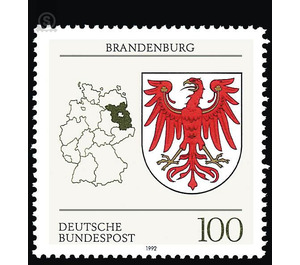Coat of arms of the Land of the Federal Republic of Germany (1) - Germany / Federal Republic of Germany 1992 - 100 Pfennig
Theme: Art & Culture
| Country | Germany / Federal Republic of Germany |
| Issue Date | 1992 |
| Face Value | 100.00 |
| Color | multi-colored white |
| Perforation | K 13 3/4 |
| Printing Type | Multicolor offset printing |
| Stamp Type | Postage stamp |
| Item Type | Stamp |
| Chronological Issue Number | 1462 |
| Chronological Chapter | GER-BRD |
| SID | 666468 |
| In 48 Wishlists | |
With "Coat of Arms of the Federal Republic of Germany", the Deutsche Bundespost continues the series of contemporary historical topics. The stamp series is intended to draw the public's attention to the young and recent history as well as the federal structure of the Federal Republic and to be a contribution to the unity of Germany. The coat of arms of the country Brandenburg is the Markish eagle. With Albrecht the bear from the Ascanian family, the history of the Mark Brandenburg begins in the 12th century as an independent German territory. Albrecht was entrusted in 1134 by the German king with the Nordmark and inherited in 1150 after the death of Heveller prince Pribislaw -Heinrich Havelland with city and castle Brandenburg as a center of rule. There a German bishopric had already been built in 948, but it had perished in the Slav revolts of 983. Since 1157, Albrecht and his descendants have been awarded the title "Margrave of Brandenburg" and thus transferred the name of the city to the entire territory, which the Ascanians acquired by conquest and settlement in the 12th and 13th centuries. Already the son Albrecht of the bear, market count Otto, led since 1170 the eagle as symbol of domination of the Ascanians for the first time in the shield. The eagle appeared under Otto II since about 1200 - already with turned head (in supervision to the left looking) - in the bunting. Since that time the eagle is coat of arms and symbol of the Mark Brandenburg. It is a red eagle, heraldic to the right (in view to the left) looks, golden claws, golden beak and golden Kleestengel (ornamental element on the wings) has and is placed on a silver (white) blazon. All rulers following the Askanians (1319/20) led the eagle as the coat of arms of the Mark Brandenburg: the Wittelsbachers (1324-1373), the Bohemian Luxembourgers (1373-1411) and the Hohenzollerns (1411 / 15-1918). The Altmark farmers, who defended their land in 1675 against the Swedes, had set the red eagle on their flags. In the large coat of arms of the Brandenburg elector and - since 1701 - Prussian kings, the red eagle took a preferred position, as the Mark Brandenburg is the country of origin and the country of the Brandenburg-Prussian monarchy. Since the beginning of the 18th century, the "wild men" standing on the right and left as shield holders next to the large coat of arms of the Prussian kings held the standards of the King of Prussia (with the black Prussian eagle) and the Elector of Brandenburg (with the red Brandenburg eagle) in their hands. In contrast to the coat of arms of Prussia and Brandenburg, which show only the "simple" eagle, on the standards the eagle carried the emblems of the king (royal crown, orb, scepter) and the elector (Kurhut, sword, scepter and breast shield with archbishop's staff) , Even today, it is quite common that standards or stands of heads of state differ significantly from the state coat of arms and national flags. Many Brandenburg and Old Town towns lead the red Brandenburg Eagle in their coat of arms, z. T. as the sole sign, z. T. together with other symbols. These include, just to name a few, Angermünde, Arendsee, Stargard, Frankfurt (Oder), Fürstenwalde, Müncheberg, Potsdam, Rhinow, Salzwedel, Seehausen (Altm.), Stendal, Templin, Werder (Havel), Wittenberge and Wriezen. Only in the 19th century, when the title of Elector of Brandenburg after the collapse of the old Holy Roman Empire of the German Nation had become an empty shell without reality, the Prussian King Friedrich Wilhelm III, in 1824 loaded the Brandenburg Eagle with the now not more used insignia Kurhut, Kurschwert and scepter. The blue breast badge with the archbishop's staff was not placed on the eagle's chest until 1864, because the Prussian king wanted to change his coat of arms and needed space on the large coat of arms, which included all the coat of arms of the Prussian monarchy. These ingredients of the 19th century do not belong to today's coat of arms of the country Brandenburg, which goes back to the historical roots: red eagle on silver (white) ground, with golden reinforcement (beak, catches) and with golden Kleestengeln on the wings, heraldisch to the right (in supervision left) looking.


